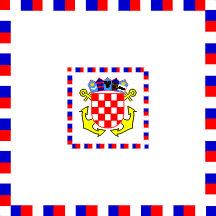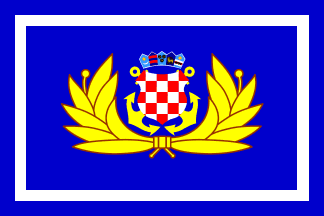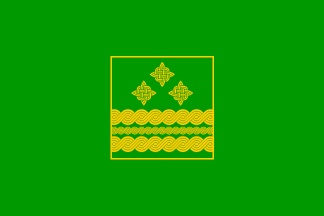
image by Željko Heimer

Last modified: 2008-06-28 by dov gutterman
Keywords: croatia | navy |
Links: FOTW homepage |
search |
disclaimer and copyright |
write us |
mirrors
See also:
Commodore (or Commodore Admiral, or Rear Admiral - Lower Half,
equal to Brigadier General) [Komodor] - The flag is the same as
the admiral's flag, but with white field.
Željko Heimer, 1 November 1999
Fleet Commander Pennat (Zapovjednik flote) : A trapezoidal
pannat, in ratio 1:2. The fly edge is 1/3 of the hoist size. The
field is blue, bordered with whider red border (outer) and
thinner white one (inner). The width of the red border is 5% of
the hoist size, and white border is half of it (2.5%). In the
blue field, there is the coat of arms with two anchors, with
vertical axis being (approximately?) half of the hoist size from
hoist. The height of the symbol is 1/2 of the hoist.
Željko Heimer, 6 November 1999
Brigade Commander Pennant (Zapovjednik brigade): A trapezoidal
pennant, same as previous in shape, all blue with the coat of
arms and anchors. The size of the symbol is 1/2 of the hoist, and
its vertical axisi is closer to the hoist the in previous flag -
according to my approximation, it is shifted to the hoist 7.5%
hoist size (i.e. for the width of the two borders in previous
flag).
Željko Heimer, 6 November 1999
Division Commander Pennant (Zapovjednik divizijuna): What I
translated here as division might be misleading. The word
"divizijun" represent a unit less then brigade, and I
think that division in English is bigger then brigade. Maybe the
word "flotilla" would come here handy, or any other
suggestion?
The flag is of the same trapezoidal shape, white with blue
border, 5% of the flag hoist wide. The coa and anchors are on the
same position as in the brigade commander pennant (i.e. shifted
to hoist 7.5% from 1/2 hoist vertical).
Željko Heimer, 6 November 1999
It may help to know that, in the Russian Army, there are two
terms translated as "division:" diviziya, which
equates roughly to a division in Western army terms, and
divizion, which is the artillery equivalent of a battalion and
therefore a subdivision of a brigade or regiment. The
Croatian naval usage may be similar.
Joseph McMillan, 6 November 1999
Group Commander Pannant (Zapovjednik odreda): The same
trapezoidal flag, with the symbol in the same position again. The
flag is red with white inner border. The width of the white
border is 5% of the flag hoist, and it "offset" from
the edge is another 5%.
Željko Heimer, 6 November 1999
Senior Officer pennant (Najstariji zapovjednik na sidris<tu
ili u luci): The same trapezoidal pennat, white with red 5%
border, and the the coat of arms and anchor on the same position
as on all previous pennants except the fleet commander pennat.
Željko Heimer, 6 November 1999
Some three years ago I had a chance to visit one of the ships
of the Croatian Navy and the captain was kind enough to let me
take a peek at the ships flag cabinet. This was five years after
the official adoption of the current naval rank flags, however
the ships were at that time not yet fully equipped with all the
flag prescribed in the 1999 regulations, due to the cost, as I
was explained - however, all the flags were supposedly
manufactured at the time and given out when the visits of high
dignitaries were expected, as appropriate. The ship, of course,
was equipped with the flags of the International Signal Code, and
to it there were several national flags, naval ensigns and naval
jacks - as flags more or less regularly needed (and used). In
addition there was the flag of the president there.
However, there I found three flags of pre-1999 origin:
One of those was the flag of the Navy that eventually became the naval jack with the "curly" shield of the coat of arms.

image by Željko Heimer, 1 October 2007
The second flag was "variation" of the current flag of the Commander of the Navy, being blue with white "orle" (inner border) with the naval cap badge consisting of the coat of arms (in the "curly" shield version) in front of two yellow anchors in saltire and surrounded with a yellow wreath of leaves. However, unlike the 1999 adopted version, this one was in 2:3 ratio, and with some minor differences in the artwork (notably, "golden" outline of the wreath elements). This was, no doubt, used as the flag of the commander of the Navy, as is its modern square version currently. I may add, that in the office of the commander of the Navy (whom I visited on the same occasion), this flag was hoisted indoors, together with the Croatian national flag and the flag of the Navy (the naval jack), all in the ratio 1:2.

image by Željko Heimer, 1 October 2007
The third flag was an entire surprise - a green flag with
yellow depiction of a general rank insignia painted in yellow. I
was explained that the flag was used "some years ago"
(which might have been around 1997) when the Chief of the General
Staff (CGS) was visiting the ship. At that time the CGS was
holding the rank of "General zbora" which was at the
time consisting of three pips and three stripes of thripple
wattle of which the middle one is thinner (according to the 1995
regulations: Odluka o oznakama cinova i dužnosti u
oružanim snagama Republike Hrvatske, 12. svibnja 1995,
Narodne novine br. 39/95, 9. 6. 1995, available on line <www.nn.hr>
). In spite of three pips, the rank is equivalent to 4-star
general, as it was also equivalent to the rank of full admiral in
the Navy. This rank was given 4 pips with 1999 regulations, by
which the ranks were made more similar to the NATO system.
The pips are, by the way, the squarish wattle ornaments based on
a design found of ancient Croatian relief from the church of
Sveta Nedjeljica (St. Domenica) in Zadar from 11th century. The
triple wattle, which is traditional Croatian ornament, is also
found on the same relief.
To the best of my knowledges, these three flags were not
regulated by any published regulation - although there may be
some internal order which established them - I was unable to find
it. It is my impression that these were manufactured as they were
needed, especially the last one which might have been an ad hoc
solution made in preparation for the visit of the CGS.
Željko Heimer, 1 October 2007